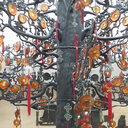UDP-glucuronosyltransferase (UGT) 1A9-overexpressing HeLa cells is an appropriate tool to delineate the kinetic interplay between breast cancer resistance protein (BRCP) and UGT and to rapidly identify the glucuronide substrates of BCRP.
Keywords
Abstract
The interplay between phase II enzymes and efflux transporters leads to extensive metabolism and low bioavailability for flavonoids. To investigate the simplest interplay between one UDP-glucuronosyltransferase isoform and one efflux transporter in flavonoid disposition, engineered HeLa cells stably overexpressing UGT1A9 were developed, characterized, and further applied to investigate the metabolism of two model flavonoids (genistein and apigenin) and excretion of their glucuronides. The results indicated that the engineered HeLa cells overexpressing UGT1A9 rapidly excreted the glucuronides of genistein and apigenin. The kinetic characteristics of genistein or apigenin glucuronidation were similar with the use of UGT1A9 overexpressed in HeLa cells or the commercially available UGT1A9. Small interfering (siRNA)-mediated UGT1A9 silencing resulted in a substantial decrease in glucuronide excretion (>75%, p < 0.01). Furthermore, a potent inhibitor of breast cancer resistance protein (BCRP), 3-(6-isobutyl-9-methoxy-1,4-dioxo-1,2,3,4,6,7,12,12a-octahydropyrazino[1',2':1,6]pyrido[3,4-b]indol-3-yl)-propionic acid tert-butyl ester (Ko143), caused, in a dose-dependent manner, a substantial and marked reduction of the clearance (74-94%, p < 0.01), and a substantial increase in the intracellular glucuronide levels (4-8-fold, p < 0.01), resulting in a moderate decrease in glucuronide excretion (19-59%, p < 0.01). In addition, a significant, albeit moderate, reduction in the fraction of genistein metabolized (f(met)) in the presence of Ko143 was observed. In contrast, leukotriene C₄ and siRNA against multidrug resistance protein (MRP) 2 and MRP3 did not affect excretion of flavonoid glucuronides. In conclusion, the engineered HeLa cells overexpressing UGT1A9 is an appropriate model to study the kinetic interplay between UGT1A9 and BCRP in the phase II disposition of flavonoids. This simple cell model should also be very useful to rapidly identify whether a phase II metabolite is the substrate of BCRP.



